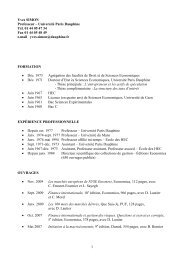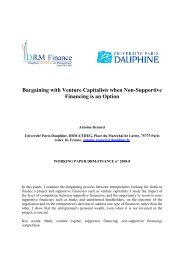Souad AJILI - CEREG - Université Paris-Dauphine
Souad AJILI - CEREG - Université Paris-Dauphine
Souad AJILI - CEREG - Université Paris-Dauphine
Create successful ePaper yourself
Turn your PDF publications into a flip-book with our unique Google optimized e-Paper software.
The Cross-Section Returns in France: Characteristics or Covariances<br />
(2000) show that this interpretation is specific to the period of study and confirm<br />
the results of the three factor model. In the same way, Lewellen (1999) confirms<br />
the superiority of the model of Fama and French (1993) compared to the model of<br />
Daniel and Titman (1997).<br />
This paper tests the three factor model of Fama and French (1993) and the characteristic<br />
model of Daniel and Titman(1997) in the case of France for a one quarter<br />
century period. Our study extends the asset pricing tests in two ways: (a) We<br />
expand the test of the three factor model to the French market for a long period.<br />
So our results are useful because they are an out of sample test of the three factor<br />
model. The main result says that the three factor model explains the common variation<br />
and the cross-section of stock returns, (b) We compare the three factor model<br />
and the characteristic model. This is the first study that makes such a comparison<br />
for the French market. Our results, which are based on Daniel and Titman (1997)<br />
tests, fail to reject the Fama and French three factor model.<br />
In the next section, we expose the theoretical framework of our study. Methodology<br />
used and database considered are discussed in the second part of the paper.<br />
In sections three and four, we summarize results and then we will conclude.<br />
1. Theoretical Framework: The Three Factor Model vs. The<br />
Characteristic Model<br />
1.1. The Three Factor Model. The basic idea of Fama and French (1993) is:<br />
the size and book to market ratio are considered as factors of risk that we must<br />
remunerate. The unconditional version 2 of the model is expressed in the following<br />
equation:<br />
E(R i ) − R f = ß i (E(R M ) − R f ) + s i E(SMB) + h i E(HML)<br />
with:<br />
E(R i ): expected stock return.<br />
R f : risk free rate.<br />
E(R M ): expected return of market portfolio.<br />
E(SMB): Small Minus Big: is the difference between the equal-weight averages<br />
of the returns on the three small stock portfolios and the three big stock portfolios.<br />
E(HML): High book to market Minus Low book to market: is the difference<br />
between the return on a portfolio of high book to market stocks and the return on<br />
a portfolio of low book to market stocks, sorted be neutral with respect to size.<br />
ß i , s i , h i : are factor loadings.<br />
Indeed, on the basis of two criteria, size and book to market (BE/ME), Fama and<br />
French construct twenty five portfolios, from a sample of the stocks of the NYSE,<br />
AMEX and NASD over 366 months (From June 1963 to December 1993). Monthly<br />
stock returns show a superiority of stocks of small capitalization and high book to<br />
market ratio, compared to the stocks of big capitalizations and low book to market<br />
ratio. This is why, they made the following regression:<br />
2 The conditional version of the model authorizes a temporal variation of the rate of stock returns<br />
and coefficients of the factors of risk.<br />
3



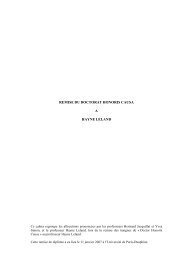

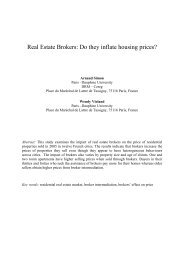
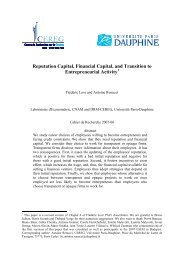

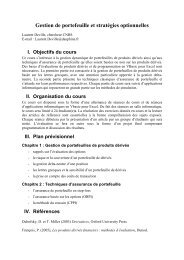

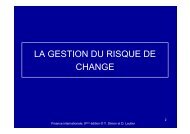
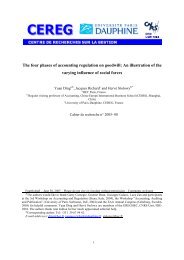
![& 6 ] ^ F ]^ - CEREG - Université Paris-Dauphine](https://img.yumpu.com/33326502/1/184x260/-6-f-cereg-universitac-paris-dauphine.jpg?quality=85)

